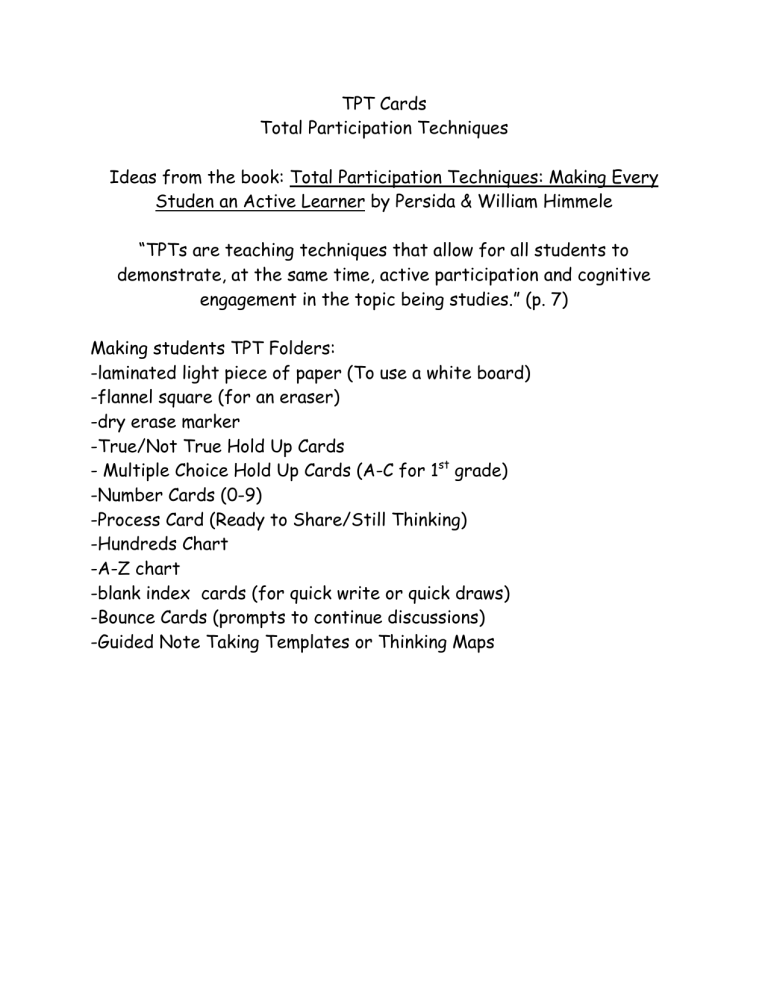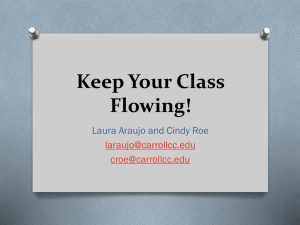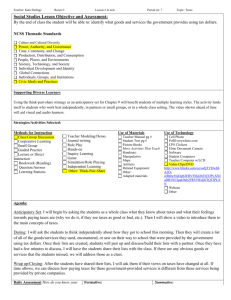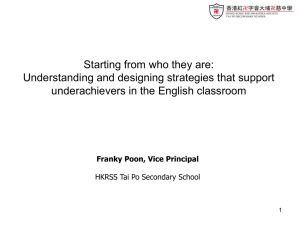TPT Cards Total Participation Techniques Ideas from the book: Total

TPT Cards
Total Participation Techniques
Ideas from the book: Total Participation Techniques: Making Every
Studen an Active Learner by Persida & William Himmele
“TPTs are teaching techniques that allow for all students to demonstrate, at the same time, active participation and cognitive engagement in the topic being studies.” (p. 7)
Making students TPT Folders:
-laminated light piece of paper (To use a white board)
-flannel square (for an eraser)
-dry erase marker
-True/Not True Hold Up Cards
- Multiple Choice Hold Up Cards (A-C for 1 st grade)
-Number Cards (0-9)
-Process Card (Ready to Share/Still Thinking)
-Hundreds Chart
-A-Z chart
-blank index cards (for quick write or quick draws)
-Bounce Cards (prompts to continue discussions)
-Guided Note Taking Templates or Thinking Maps
Think Pair Share
1. Ask students to reflect on an idea.
2. Students will pair up and turn and talk to a partner.
3. They will discuss their answers.
HOT:
Use prompts that require students to analyze various points of view or how components that directly related to your objective fit together. Or you can have students evaluate something by defending it based upon what they have learned.
Quick Writes
1. Select Prompt
2. Give students a specific amount of time to think and jot their response (3-5 minutes)
3. Follow up with Think-Pair-Share
HOT:
Ask students to explain the meaning or make connections between concepts and the world around them. Use phrases like: “In what ways…”, “Why is this important”, How does this relate to our lives?” or “How might things be different if…”
2. Students will think about the meaning and create a visual image that represents the concept during a specific time frame (3-5 minutes).
3. They will share their answer in Think-Pair-Share, Chalkboard
Splash, or small group.
HOT:
Students will share the reasons they chose that particular representation.
Quick Draws
1. Select a major concept from lesson or unit.
Chalkboard Spalsh
1. Select Prompt, question or sentence starter.
2. Students generate responses and randomly copy them onto whiteboards or chart papers.
3. Students will wander around looking for similarities, differences and surprises and record their reactions.
4. Students will share their observations in a small group.
HOT:
After students have recorded answers, ask: “So what? Why is this important?” What new questions arise from their similarities, differences, and surprises?
Thumbs Up When Ready
1. Ask students to reflect on prompt.
2. Explain that when they have a thought or are finished, they should but their thumb up to show they are ready to move on.
3. They will discuss their idea in Think-Pair-Share.
HOT:
Have students justify their thinking and to give a reason for their justification.
Processing Cards
1. Give students cards that say:
Still Thinking
&
Ready to Share
2. All students will begin with the Still Thinking side.
3. When students are finished, they flip the card to Ready to
Share.
4. Be sure to have an extra extension ready for fast thinkers.
HOT:
Have students justify their thinking and to give a reason for their justification.
Similes
1. Create similes using some of the things you are studying.
2. Students will come up with an explanation to say why the simile might be true.
3. They will discuss their answers in Think-Pair-Share, small group, or Chalkboard Splash.
HOT:
Have students come up with their own similes: (Topic) was/is like
________ in that ___________.
Ranking
1. Select items that can be ranked.
2. Give groups of students a specific criteria in which to rank the items.
3. Students will provide a justification for they way they chose to rank the concepts.
HOT:
This analysis is HOT. Here are some ideas: most to least or least to most -important, influential, changed, affected, likable, etc.
Numbered Heads Together
1. Have the groups number themselves off (1-4).
2. Confirm numbers by having each number stands. (To ensure everyone know their number.
3. Give the questions and inform all members that they need to be ready to present the information.
4. When sharing, call out the number for the team member presenting.
HOT:
Depends upon the activity or information asked for.
Thumbs Up/Down Vote
1. Ask a question that requires a yes/no or agree/disagree answer.
2. Student will show a thumbs up for yes/agree or thumbs down for no/disagree answers. They can but thumb in middle if they are neutral or not sure.
3. Make sure all students vote!
HOT:
Link voting to a Think-Pair-Share and have students justify their reasons for their vote.
Hold Ups
There are many kinds of these but they all work the same way.
1. Ask students to think about and discuss responses to teacher questions.
2. Students will pair up and turn and talk to a partner or in small groups.
3. Say “Hold it up.”
4. Select students to share their groups reasons for their choice.
HOT:
Provide opportunities for students to explain their thinking, hear opposite points of view, and to change their minds if they want during a revote. Use questions that can be analyzed or connections can be made with prior learning or other things.
2. Number Card - Greater Than/Less Than, Sum of, difference of
3. True/Not True/Unable to Determine/True with
Modifications
4. Multiple Choice – A-C for 1 st Grade
5. White Board
Types of Hold Ups
1. Selected Response – Yes/No, or types of Matter (L/S/G)
Line Ups or Inside/Outside Circle idea/question that allows discussion.
2. Students will stand in two parallel lines or concentric circles.
3. They will discuss their idea/answers.
4. Ring a bell and instruct students on how to move. (Two steps to their left)
HOT:
Do not use factual questions. Make sure your questions allow for justification. “What are your thoughts about…” “In what ways has
____ affected _____?”
1. Ask students to reflect on an idea. Be sure it is an
Categorizing and Sorting
1. When categorizing, give students a specific number of items.
Ask them to sort them into like piles and create titles based on the criteria they used to sort them..
2. For sorting, determine the names of the groups and proved items to sort within the groups.
HOT:
They have to explain why they sorted them that way or placed them in that group..
Bounce Cards
1. Select a student to model a conversation for the class, but practice with them ahead of time.
2. Model the wrong way to have a conversation first.
3. Discuss 3 ways to respond in conversation.
Inquire: Ask questions regarding what their peer says.
4. Model conversation with Bounce Sentence Starters.
5. Allow students to practice.
HOT:
Ask students why learning to listen and talk is important in everyday life.
Responding to Conversation
1.
Bounce : Take what their peer says and bounce off or extend the idea.
“That reminds me of…”
“I agree, because…”
“Yes. Another example is…”
“That’s a great point.”
2.
Sum It Up : Rephrase what their peers say and comment on certain parts.
“I hear you saying that…”
“I like how you said…”
3.
Inquire : Ask questions regarding what their peer says.
“Can you tell me more about?”
“I’m not sure I understand…?”
“Have you thought about…?”
Mouth It –
Other Ideas
Students silently mouth the answer.
Air-Write It – Students air write the answer.
Show Me Using Your Fingers – Hold up a number of fingers.
Act It Out
Role Play
Concept Charades – Create and show an action that reflects what the teacher is asking.
Simulations
Cut and Pastes
Confer, Compare, and Clarify
1. Students will pair up to discuss their notes. They will confer
(share a one sentence summary of what they believe is most important), compare (compare what each of them recorded), and clarify (responding to questions they had during lesson).
2. One pair joins another pair and discusses things that still need clarification.
3. Unanswered questions are recorded on a Chalkboard Splash.
HOT:
Discuss students notes in regards to whether or not they included the most important parts of the lesson.
Guided Notes and Graphic Organizers
1. Teach prepares handout ahead of time with cures and spaces for students to fill in key information.
2. Students fill in graphic organizers to as a visual way to aid in understanding. (THINKING MAPS!)
HOT:
Use prompts that require students to connect their learning to the outside world.
Idea: Add a footer to your handout that requires a student to do a
Quick Write after the lesson. Connect the question to the lesson’s big idea.
Anticipatory Guide
1. Create true/false statements related to you content.
2. Have students respond, placing their answer in the before column.
3. Students will Think-Pair-Share and explain their reasoning.
Bring questions to the whole class.
4. Go over each statement as you come to in in your lesson.
HOT:
Do not ask questions that are clearly true or false and be careful not use always or never. Ask questions that get students to think and make connections from what they know to what you will be teaching.



